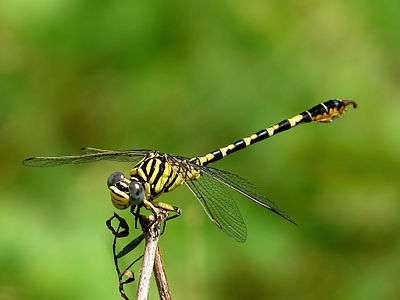Paragomphus lineatus
Paragomphus lineatus,[2] Lined hooktail, is a species of dragonfly in the family Gomphidae. It is a widespread species; recorded from India to Turkey.[1][3]
| Paragomphus lineatus | |
|---|---|
 | |
| Male | |
| Scientific classification | |
| Kingdom: | |
| Phylum: | |
| Class: | |
| Order: | |
| Family: | |
| Genus: | |
| Species: | P. lineatus |
| Binomial name | |
| Paragomphus lineatus (Selys, 1850) | |
Description and habitat
It is a black and yellow dragonfly with bluish grey eyes. Its thorax is yellow, marked with blackish-brown stripes. There is a black dorsal line bordering the mesothoraoic collar on either side of the mid-dorsal carina and an oblique antehumeral line to join this line in its upper part, thus enclosing a thin stripe of the yellow colour. There is a line on the humeral suture and two lateral lines close together on the postero-lateral suture. Abdomen is black marked with yellow basal rings. Segment 1 has the sides broadly yellow and a large dorsal apical spot. Segment 2 has a sub-dorsal black line on each side enclosing a dorsal yellow spot. Segments 3 to 7 have broad black apical rings. There is a lateral black line runs from the apical ring on each side and extends to the yellow base. Segments 8 and 9 have wide dilatations at their sides. They are black on the dorsum except for a fine basal rings. Segment 10 is yellow, with black on the basal half of the dorsum. Anal appendages are yellow and hood-shaped. Female is similar to the male; but lacks the dilatations on the last abdominal segments.[4]
 Male
Male_(2).jpg) Female
Female
It is commonly found near streams, rivers, ponds and lakes where it breeds.[5][4][6][7][8]
See also
- List of odonates of India
- List of odonata of Kerala
| Wikimedia Commons has media related to Paragomphus lineatus. |
References
- Clausnitzer, V. (2009). "Paragomphus lineatus". IUCN Red List of Threatened Species. 2009: e.T158710A5271177.
- Martin Schorr; Dennis Paulson. "World Odonata List". University of Puget Sound. Retrieved 12 Oct 2018.
- K.A., Subramanian; K.G., Emiliyamma; R., Babu; C., Radhakrishnan; S.S., Talmale (2018). Atlas of Odonata (Insecta) of the Western Ghats, India. Zoological Survey of India. pp. 250–251. ISBN 9788181714954.
- C FC Lt. Fraser (1934). The Fauna of British India, including Ceylon and Burma, Odonata Vol. II. Red Lion Court, Fleet Street, London: Taylor and Francis. pp. 230-234.
- "Paragomphus lineatus Selys, 1850". India Biodiversity Portal. Retrieved 2017-02-12.
- C FC Lt. Fraser (1924). A Survey of the Odonate (Dragonfly) Fauna of Western India and Descriptions of Thirty New Species (PDF). p. 477.
- Paul, Shaun; K. Kakkassery, Francy (2013). "Taxonomic and Diversity Studies on Odonate Nymphs by Using Their Exuviae" (PDF). 1 (4): 47–53. Cite journal requires
|journal=(help) - "Paragomphus lineatus Selys, 1850". Odonata of India, v. 1.00. Indian Foundation for Butterflies. Retrieved 2017-02-12.
